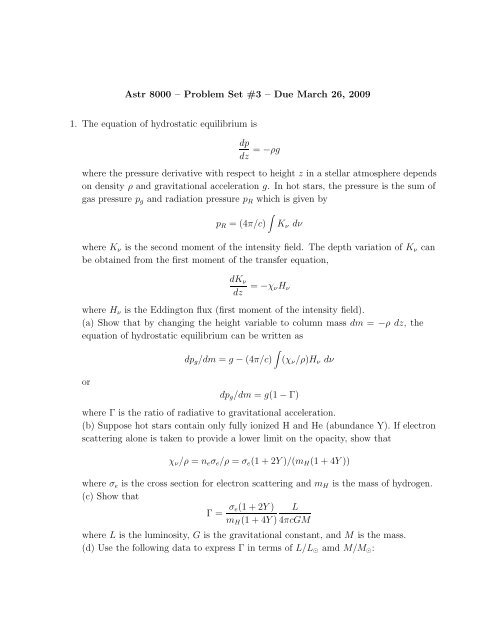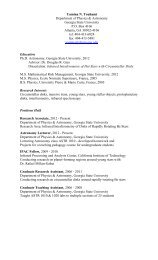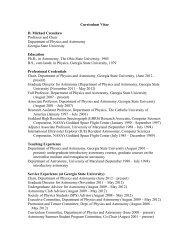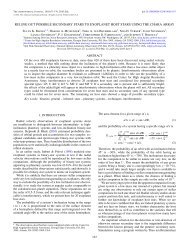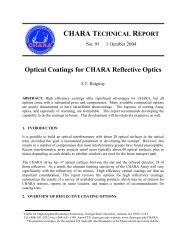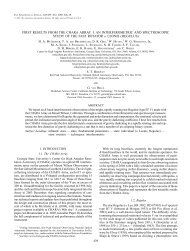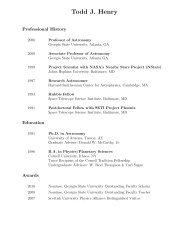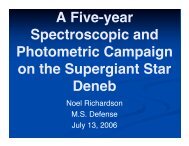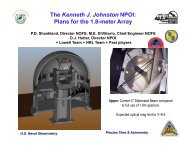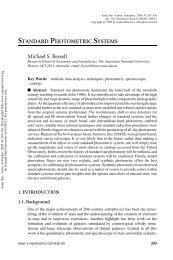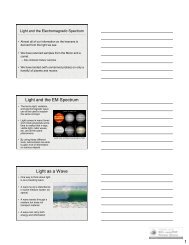Astr 8000 – Problem Set #3 – Due March 26, 2009 1. The equation ...
Astr 8000 – Problem Set #3 – Due March 26, 2009 1. The equation ...
Astr 8000 – Problem Set #3 – Due March 26, 2009 1. The equation ...
You also want an ePaper? Increase the reach of your titles
YUMPU automatically turns print PDFs into web optimized ePapers that Google loves.
<strong>Astr</strong> <strong>8000</strong> <strong>–</strong> <strong>Problem</strong> <strong>Set</strong> <strong>#3</strong> <strong>–</strong> <strong>Due</strong> <strong>March</strong> <strong>26</strong>, <strong>2009</strong><br />
<strong>1.</strong> <strong>The</strong> <strong>equation</strong> of hydrostatic equilibrium is<br />
dp<br />
dz = −ρg<br />
where the pressure derivative with respect to height z in a stellar atmosphere depends<br />
on density ρ and gravitational acceleration g. In hot stars, the pressure is the sum of<br />
gas pressure p g and radiation pressure p R which is given by<br />
∫<br />
p R = (4π/c)<br />
K ν dν<br />
where K ν is the second moment of the intensity field. <strong>The</strong> depth variation of K ν can<br />
be obtained from the first moment of the transfer <strong>equation</strong>,<br />
dK ν<br />
dz = −χ νH ν<br />
where H ν is the Eddington flux (first moment of the intensity field).<br />
(a) Show that by changing the height variable to column mass dm = −ρ dz, the<br />
<strong>equation</strong> of hydrostatic equilibrium can be written as<br />
or<br />
∫<br />
dp g /dm = g − (4π/c) (χ ν /ρ)H ν dν<br />
dp g /dm = g(1 − Γ)<br />
where Γ is the ratio of radiative to gravitational acceleration.<br />
(b) Suppose hot stars contain only fully ionized H and He (abundance Y). If electron<br />
scattering alone is taken to provide a lower limit on the opacity, show that<br />
χ ν /ρ = n e σ e /ρ = σ e (1 + 2Y )/(m H (1 + 4Y ))<br />
where σ e is the cross section for electron scattering and m H is the mass of hydrogen.<br />
(c) Show that<br />
Γ = σ e(1 + 2Y ) L<br />
m H (1 + 4Y ) 4πcGM<br />
where L is the luminosity, G is the gravitational constant, and M is the mass.<br />
(d) Use the following data to express Γ in terms of L/L ⊙ amd M/M ⊙ :
σ e = 6.65 × 10 −25 cm 2 electron −1 , Y = 0.1, m H = <strong>1.</strong>673 × 10 −24 g, L ⊙ = 3.85 × 10 33<br />
erg s −1 , M ⊙ = <strong>1.</strong>989 × 10 33 g, and G = 6.67<strong>26</strong> × 10 −8 cm 3 g −1 s −2 .<br />
(e) Howarth & Prinja (1989, ApJS, 69, 527) give a mass and luminosity calibration<br />
for O stars that can be fit by<br />
L/L ⊙ = 317(M/M ⊙ ) <strong>1.</strong>82 .<br />
Use this relationship with your expression for Γ to find the maximum possible<br />
stellar mass (i.e., where outward radiative acceleration equals inward gravitational<br />
acceleration). [40]<br />
2. Use the Saha ionization <strong>equation</strong> to estimate the ratio of the numbers of negative<br />
hydrogen ions to neutral hydrogen atoms in the solar atmosphere. Use the form of<br />
the Saha <strong>equation</strong> given by<br />
N j /N j+1 = n e<br />
U j (T)<br />
U j+1 (T) C I T −3/2 e χ I/(kT)<br />
where C I = 2.07 × 10 −16 in c.g.s. units. Assume that the partition functions for<br />
neutral hydrogen and the negative hydrogen ion equal 2 and 1, respectively. Further<br />
assume an electron density of 5 × 10 13 cm −3 and a temperature of 6300 ◦ K (typical<br />
values near optical depth unity). [30]<br />
3. Calculate the discrete ordinate solution to the grey atmosphere<br />
I i (τ) = 3 4 F(τ + Q + µ i +<br />
n−1 ∑<br />
α=1<br />
S = J(τ) = 3 n−1<br />
4 F(τ + Q + ∑<br />
α=1<br />
L α e −kατ<br />
1 + µ i k α<br />
)<br />
L α e −kατ )<br />
using the single Gauss quadrature results for n = 4 in Table 10.1 from Collins (1989,<br />
Fundamentals of Stellar <strong>Astr</strong>ophysics [New York: Freeman]; see next page). <strong>The</strong><br />
quadrature points are<br />
µ = [.9602899, .7966665, .5255324, .1834346]<br />
(Chandrasekhar 1960, Radiative Transfer [New York: Dover]). Make a plot of the<br />
limb darkening law for the surface intensity (I(µ) at τ = 0) for both the Eddington<br />
approximation and the discrete ordinate method. Determine the degree of radiation<br />
anisotropy<br />
(I(µ = .9602899) − I(µ = .1834346))/I(µ = .9602899)<br />
fro τ = 0, 1, 10, and 100. Plot the temperature versus depth relation, T/T eff versus<br />
log τ, between τ = 0.01 and 100 for both the Eddington approximation result and the<br />
discrete ordinate solution. [30]


